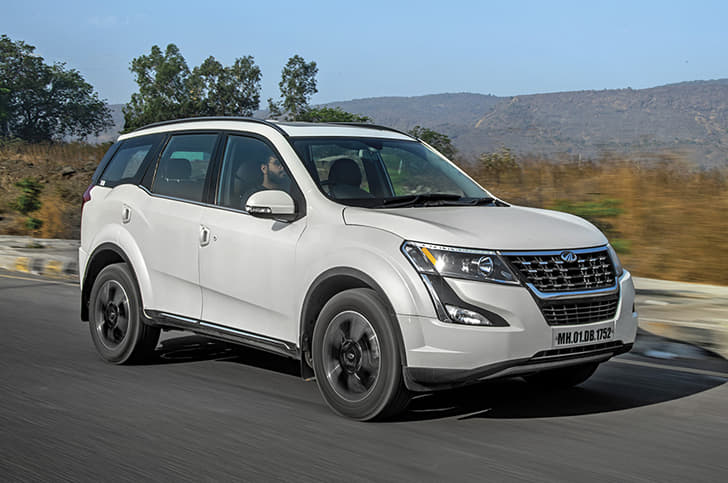The XUV300 is our current pick of the diesel compact SUV crop, having seen off the rest of the segment just a few months ago in our big comparison test. It impressed us on almost every count and was a huge leap forward for Mahindra; but let’s not forget, though it’s been heavily reworked for India, the XUV300 started life as a SsangYong Tivoli. On its home turf of South Korea, SsangYong frequently does battle in various segments with another local brand – you might have heard of it – Hyundai. In a way, that battle has now come to our shores, as the XUV300 defends its title of best diesel compact SUV against the new Hyundai Venue. These two are the newest and freshest cars in the segment, but which one should you pick? Read on to find out.
Impactful compacts
It’s not easy getting the proportions right on a sub-four-metre SUV, but Hyundai has done a commendable job. It looks tall enough without feeling truncated, and in profile, it looks like a mini-Creta. The front is rather unique in this segment with its split-headlamp treatment. Although the large chrome grille seems a bit overdone, there’s no doubt it’ll grab eyeballs.
The XUV300 is visibly wider than the Venue, and although they’re exactly the same length, the Mahindra has a 100mm longer wheelbase! More than that though, it’s hard to escape the fact that the XUV300 is a longer car (the 4.2m SsangYong Tivoli) that’s been cut down to size and this shows in its truncated boot and upsets the proportions quite a bit. It does, however, have some interesting details at the front and rear to help distract you from this.
What’s on the inside
The Venue’s all-black colour scheme might seem a little dour, but the dashboard has a simple and well-thought-out design. The ergonomics are spot on, there are plenty of rich-looking plastics, and the buttons have a nicely damped feel. Special mention must go to the new Hyundai steering wheel which looks like it belongs in a far more expensive car. Also worthy of mention is the 8.0-inch touchscreen, which is well-integrated into the dashboard.
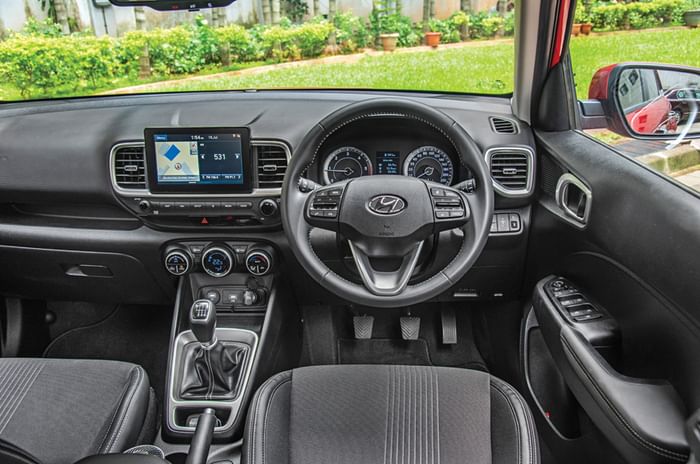
The XUV300’s interior comes a very close second in terms of quality, with the well-finished switchgear being particularly noteworthy. The lighter colours lend a greater sense of space to the already-larger cabin. However, some parts of the cabin look and feel a bit dated – particularly the air-con controls and other buttons lower down – and don’t feel in sync with the rest of the cabin.
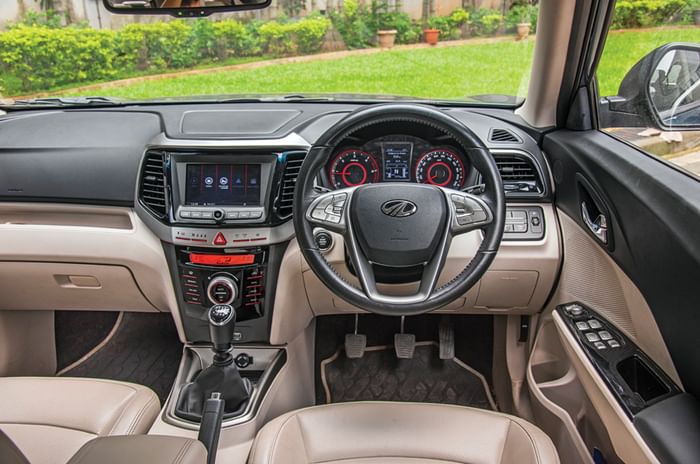
Both cars get a lot of safety kit, the commonalities including ESP, hill-start assist, ABS with EBD, Isofix child-seat anchors, six airbags and rear parking sensors with a camera. The XUV300 W8 (O) goes a step further, however, with front parking sensors, disc brakes at the rear, and a driver-knee airbag. Both cars get auto headlamps, auto climate control, a sunroof, cruise control and a touchscreen with Android Auto and Apple CarPlay. The Venue also offers Hyundai’s Blue Link – a SIM-based service paired to a smartphone app offering several ‘connected’ features, as well as a wireless mobile charger. The XUV300 W8 (O) again goes a bit further, with auto wipers, an auto-dimming inside mirror, heated wing mirrors, dual-zone climate control and engine stop-start.
| Equipment | ||
|---|---|---|
| Hyundai Venue SX (O) | Mahindra XUV300 W8 (O) | |
| Projector headlamps | Xenon | Xenon |
| LED DRLs | Available | Available |
| Keyless entry and go | Available | Available |
| Auto headlamps | Available | Available |
| Auto wipers | NA | Available |
| Auto climate control | Single-zone | Dual-zone |
| Auto-dimming inside mirror | NA | Available |
| Heated wing mirrors | NA | Available |
| Rear AC vent | Available | NA |
| Sunroof | Available | Available |
| Touchscreen | 8.0-inch | 7.0-inch |
| Apple CarPlay/Android Auto | Available | Available |
| Rear-view camera | Available | Available |
| Parking sensors (f/r) | NA / Available | Available / Available |
| Tyre pressure monitoring system | NA | Available |
| Wireless phone charger | Available | NA |
| ABS/ESP | Available | Available |
| Airbags | 6 | 7 |
Every millimetre counts
The part-leatherette seats on the Venue are soft and provide good overall support at the front, and outward visibility is good. The back seat offers sufficient support and has the advantage of a rear AC vent, although some might find the backrest to be a tad upright. Headroom is ample, but width and legroom are considerably less than what you get in the XUV300, and tall passengers will find their knees brushing up against the front seat.
That space seems to have been apportioned to the boot, which at 350 litres is almost 100 litres more than the Mahindra’s. In fact, most premium hatchbacks have more boot space than the XUV300.
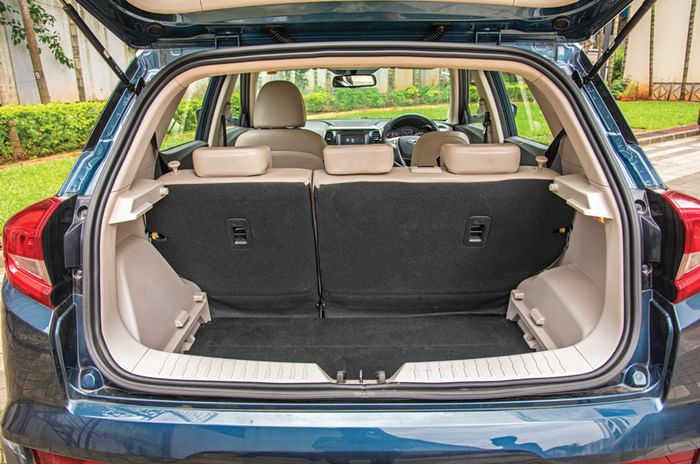
The XUV’s back seat is likely segment-best on space, but falls behind when it comes to thigh support. The lighter colours give a better sense of airiness and there’s the advantage of an adjustable headrest and three-point seat belt for the middle passenger. The front seats are wide and widely adjustable, and the full-leatherette upholstery is a premium touch.
| Dimensions | ||
|---|---|---|
| Hyundai Venue SX (O) | Mahindra XUV300 W8 (O) | |
| Length | 3995mm | 3995mm |
| Width | 1770mm | 1821mm |
| Height | 1605mm | 1627mm |
| Wheelbase | 2500mm | 2600mm |
| Tyre size | 215/65 R16 | 215/55 R17 |
Walking the torque
Start the Venue’s 90hp diesel engine and it will impress you with the level of refinement at idle. It does, however, start to get a little gruff as you move up the rev band, and though it’s miles better than most of its rivals, amazingly, it’s not better than the XUV’s 1.5-litre turbo-diesel engine. The XUV does serve up a few more vibrations (and decibels) at idle, but it smoothens out the moment you get moving.
On the move, Hyundai’s 1.4-litre CRDi engine – which can feel a bit out of its depth in the Creta – feels right at home in the smaller Venue. There isn’t too much turbo lag, but the engine really wakes up after 2,000rpm, and as with most small diesel engines, you learn to work your way around the lack of low-end response. Though it revs to 5,000, the power tails off after 3,500rpm, so you’re left with a small powerband and a bit of shifting to do. Luckily, the clutch is light and the shifts are short and snappy, so it’s not a chore.
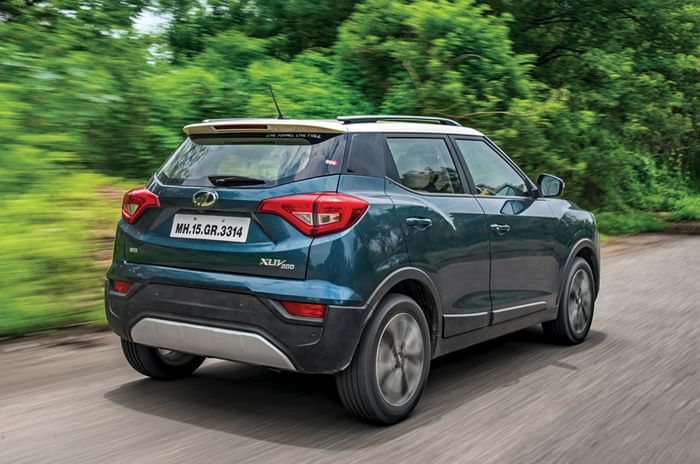
The XUV’s clutch is light too, but the pedal travel is quite long, so judging the bite point takes a little getting used to. Parallelly, the gear shift is also light but the throws are a bit too long, robbing it of a bit of driving ease and enjoyment. There’s no shortage of enjoyment in the performance, which is borderline explosive. Thank the class-leading 117hp and 300Nm torque for this, but the XUV300 just flies. Turbo lag is less pronounced, with power coming in as early as 1,500rpm but it suffers from a rather short powerband as well, and here too, you’ll find yourself shifting a lot.
In our tests, the XUV300 did the 0-100kph run in 11.85sec which is almost 1sec faster than the Venue. Even in in-gear acceleration, the XUV300 gets the best of Venue, being 2sec quicker from 20-80kph in third, and 3.8sec quicker from 40-100kph in fourth.
| Engine and Performance | ||
|---|---|---|
| Hyundai Venue SX (O) | Mahindra XUV300 W8 (O) | |
| Engine | 4-cyl, 1396cc, turbo-diesel | 4-cyl, 1497cc, turbo-diesel |
| Power | 90hp at 4,000rpm | 117hp at 3,750rpm |
| Torque | 220Nm at 1,500-2,750rpm | 300Nm at 1,500-2,500rpm |
| Gearbox | 6-speed manual | 6-speed manual |
| Performance | Acceleration (from rest) | Acceleration (from rest) |
| 20kph | 1.29s | 1.09s |
| 40kph | 2.88s | 2.79s |
| 60kph | 5.17s | 4.91s |
| 80kph | 8.38s | 7.66s |
| 100kph | 12.72s | 11.85s |
| 120kph | 19.48s | 17.42s |
| Acceleration in gear | ||
| 20-80kph (in 3rd gear) | 11.82s | 9.74s |
| 40-100kph (in 4th gear) | 14.44s | 10.67s |
Keeping it together
The Venue’s suspension has an underlying stiffness to it. It handles small potholes and road undulations quietly at low speeds. The ride is flat enough for the most part but the moment you go faster, you notice some vertical movement. Also, the steering is a bit too light and disconnected, which may be great for low-speed manoeuvrability but it doesn’t inspire a huge amount of confidence. And what doesn’t help too much either, especially when you are at speed, is that the Venue has a small footprint.

The XUV’s steering isn’t a lot better, but it does at least feel a touch quicker, and you can dial in some artificial weight using the unique ‘steering mode’ settings. Despite riding on 17-inch wheels (the Venue gets 16-inchers), the XUV300 has the superior ride quality thanks to an overall softer suspension. At low speeds, only sharp potholes register in the cabin, but the ride remains stable over rough patches of road, allowing you to carry more speed as well. Even on highways, the wider track of the car gives it a planted feel and there’s not much of bobbing at high speeds.
Civil war
The Hyundai Venue is a superb all-rounder; it has the right amount of performance, an easy driving manner, a strong equipment list, good looks and an upmarket cabin. The slightly choppy ride is a minor inconvenience, while the unimpressive rear-seat space is a more significant one.
The XUV300, meanwhile, dials everything up a little further. Performance is superior, the equipment list has more feel-good features, and the back seat is vastly more spacious. Can you overlook its tiny boot? Some might. The issue, however, is that this top-spec W8 (O) asks for a full Rs 1.3 lakh over the top-spec Venue SX (O), and that’s simply too much. Even the next variant down is Rs 11,000 dearer than this Venue SX (O), and it loses a lot of equipment.
So while the XUV delivers a lot, the Venue feels like all the compact SUV you need, and in true Hyundai fashion, it’s the better value proposition, making it our winner.
| Price and Verdict | ||
|---|---|---|
| Hyundai Venue SX (O) | Mahindra XUV300 W8 (O) | |
| Price (ex-showroom, Delhi) | Rs 10.84 lakh | Rs 12.14 lakh |
| Rating | 8/10 | 8/10 |
| Verdict | A great all-rounder that’s good value for money. | High on performance and equipment, but expensive. |






















